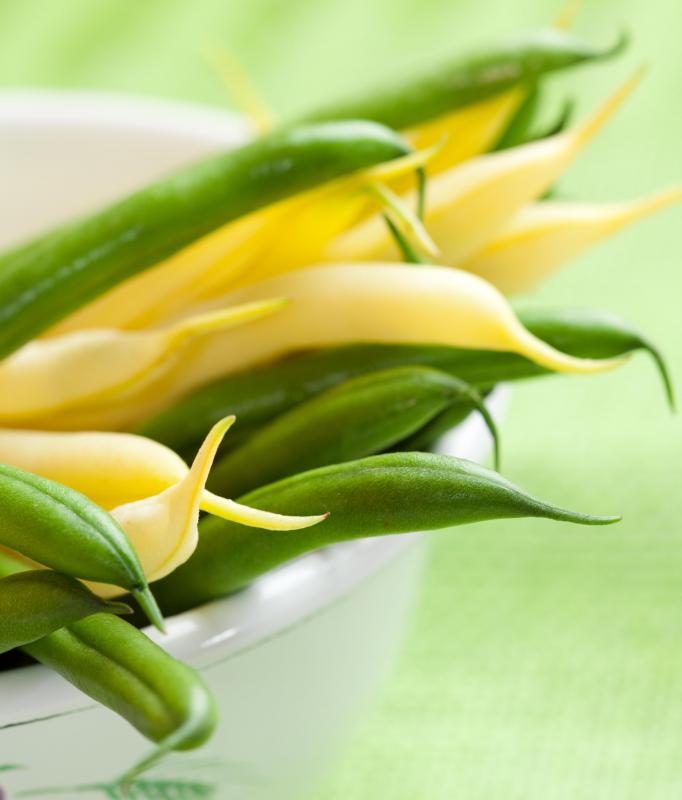At DelightedCooking, we're committed to delivering accurate, trustworthy information. Our expert-authored content is rigorously fact-checked and sourced from credible authorities. Discover how we uphold the highest standards in providing you with reliable knowledge.
What are Pole Beans?
Pole beans are beans which are bred to grow in the form of vines which cling to poles or trellises. Their growth habit makes them very easy to harvest, and many commercial bean producers grow pole beans for this very reason. These beans are also very easy to grow at home, as long as you live in a temperate to warm climate. Numerous pole bean cultivars are available, ranging from snow white haricot beans to colorful pinto beans; for extra diversity, you can plant several varietals in your garden.
The scientific name for the common bean is Phaeolus vulgaris. These beans are native to South America, where they have been cultivated as a staple food for centuries. South Americans also developed a wide range of bean cultivars which were adapted to specific soils or regions. Some were cultivated for specific traditional recipes, as well. When Europeans reached the Americas, they were introduced to common beans and they became a big hit when they were imported to Europe.

For Native Americans, pole beans were one of the “three sisters,” three staple foods which grew well together and provided an immense amount of nutrition. The other two sisters were corn and squash. Pole beans could be trained to grow up corn stalks, while squash could be planted between rows of corn. These three ingredients were used in many traditional dishes and they continue to be popular today.

Growing pole beans is extremely easy. Start by obtaining seeds from a garden store; some seeds are specifically designed to produce green or snap beans, beans which are harvested when young and eaten whole. Others are intended to produce dried beans which can be kept over the winter. When the last chance of frost has passed and ambient temperatures remain stable, plant the beans in loamy, sandy soil which has been mixed with compost or other organic material. Within days, the beans will sprout, and you can install poles or trellising to support the vines.

Green beans will mature within 10 days of flowering, which generally happens around two months after the beans have been planted. If you want a steady supply of fresh green beans, you can stagger your plantings; just remember that the beans will die off in cool winter weather, so stop planting around two months before the cold sets in. You can also leave the beans on the vine to make dried beans.

Bean plants are very sensitive to cold and wet. As the beans grow, make sure that all of the plant is staked up off the ground, so that it doesn't rot. Also avoid handling the beans when they are moist, as you can inadvertently contribute to the spread of bean diseases.
AS FEATURED ON:
AS FEATURED ON:














Discussion Comments
@rallenwriter -- My grandmother used to call them preacher beans too, although their real name is rattlesnake pole beans.
They're pretty simple to grow, just make sure that you plant them in nice, loamy soil, and make sure they don't get too dry -- rattlesnake pole beans are very drought resistant, but you should water them often.
You should plant about four to six seeds per pole.
The only tip about harvesting rattlesnake pole beans is to get them when they're young. You should pick them when they get to be about six inches long.
If you want to use them for drying, simply leave them on your pole bean trellis until they dry out.
Best of luck!
Has anybody ever grown any "preacher pole beans" or "rattlesnake pole beans"? I think that's what they're called -- my aunt used to grow them in her garden all the time, and now that she's passed on I'd like to do the same.
Does anybody have any tips?
One of my favorites is the purple pole beans. They just add such a kick of color to your garden, and they're really tasty too.
My husband prefers the traditional Italian pole beans, but for me, purple all the way!
Every spring I think about planting beans, and always seem to dismiss the idea for one reason or another. But it sounds like they are really easy to grow! I'll have to finally give it a try next year.
Post your comments